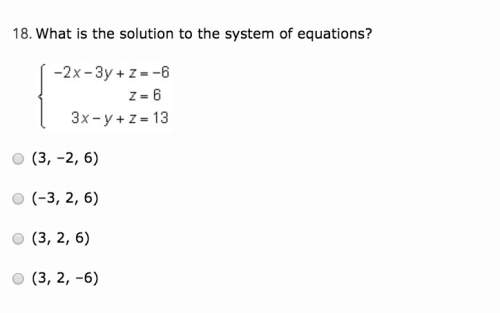
Mathematics, 10.07.2019 07:00 SophieCasey
What is the equation, in slope-intercept form, of the line that passes through (0, −2) and has a slope of −3? y = −3x − 2 y = −3x + 2 y = −2x + 3 y = −2x − 3

Answers: 1


Another question on Mathematics

Mathematics, 21.06.2019 16:30
Jackie purchased 3 bottles of water and 2 cups of coffee for the family for $7.35. ryan bought 4 bottles of water and 1 cup of coffee for his family for 7.15. how much does each bottle of water cost? how much does each cup of coffee cost?
Answers: 3

Mathematics, 21.06.2019 18:30
Do some research and find a city that has experienced population growth. determine its population on january 1st of a certain year. write an exponential function to represent the city’s population, y, based on the number of years that pass, x after a period of exponential growth. describe the variables and numbers that you used in your equation.
Answers: 3

Mathematics, 21.06.2019 19:00
Acompany manufactures large valves, packed in boxes. a shipment consists of 1500 valves packed in 75 boxes. each box has the outer dimensions 1.2 x 0.8 x 1.6 m and the inner dimensions 1.19 x 0.79 x 1.59 m. the boxes are loaded on a vehicle (truck + trailer). the available capacity in the vehicle combination is 140 m3. each valve has a volume of 0.06 m3. - calculate the load factor on the box level (%). - calculate the load factor on the vehicle level (%). - calculate the overall load factor (%).
Answers: 1

Mathematics, 21.06.2019 21:30
In a test for esp (extrasensory perception), the experimenter looks at cards that are hidden from the subject. each card contains either a star, a circle, a wave, a cross or a square.(five shapes) as the experimenter looks at each of 20 cards in turn, the subject names the shape on the card. when the esp study described above discovers a subject whose performance appears to be better than guessing, the study continues at greater length. the experimenter looks at many cards bearing one of five shapes (star, square, circle, wave, and cross) in an order determined by random numbers. the subject cannot see the experimenter as he looks at each card in turn, in order to avoid any possible nonverbal clues. the answers of a subject who does not have esp should be independent observations, each with probability 1/5 of success. we record 1000 attempts. which of the following assumptions must be met in order to solve this problem? it's reasonable to assume normality 0.8(1000), 0.2(1000)%30 approximately normal 0.8(1000), 0.2(1000)% 10 approximately normal srs it is reasonable to assume the total number of cards is over 10,000 it is reasonable to assume the total number of cards is over 1000
Answers: 1
You know the right answer?
What is the equation, in slope-intercept form, of the line that passes through (0, −2) and has a slo...
Questions


Mathematics, 21.09.2019 16:30


Chemistry, 21.09.2019 16:30

Mathematics, 21.09.2019 16:30


English, 21.09.2019 16:30

Mathematics, 21.09.2019 16:30


Social Studies, 21.09.2019 16:30



Social Studies, 21.09.2019 16:30



Mathematics, 21.09.2019 16:30

Mathematics, 21.09.2019 16:30

Physics, 21.09.2019 16:30

History, 21.09.2019 16:30





